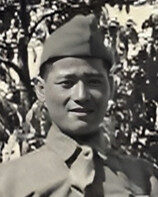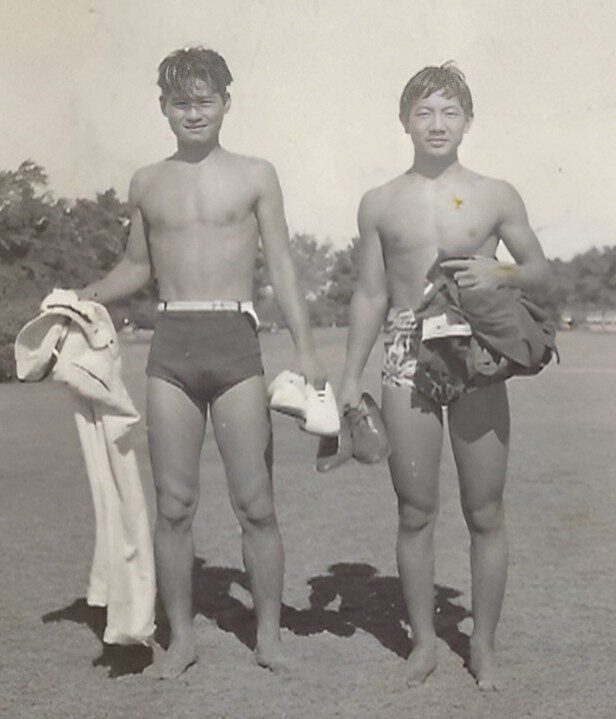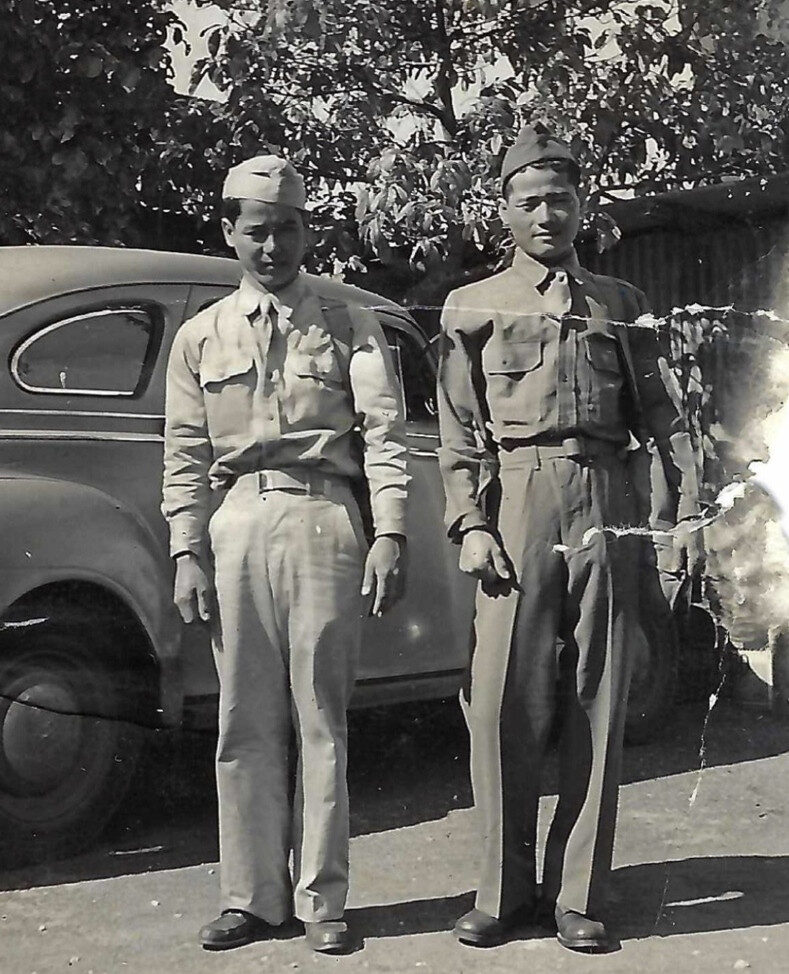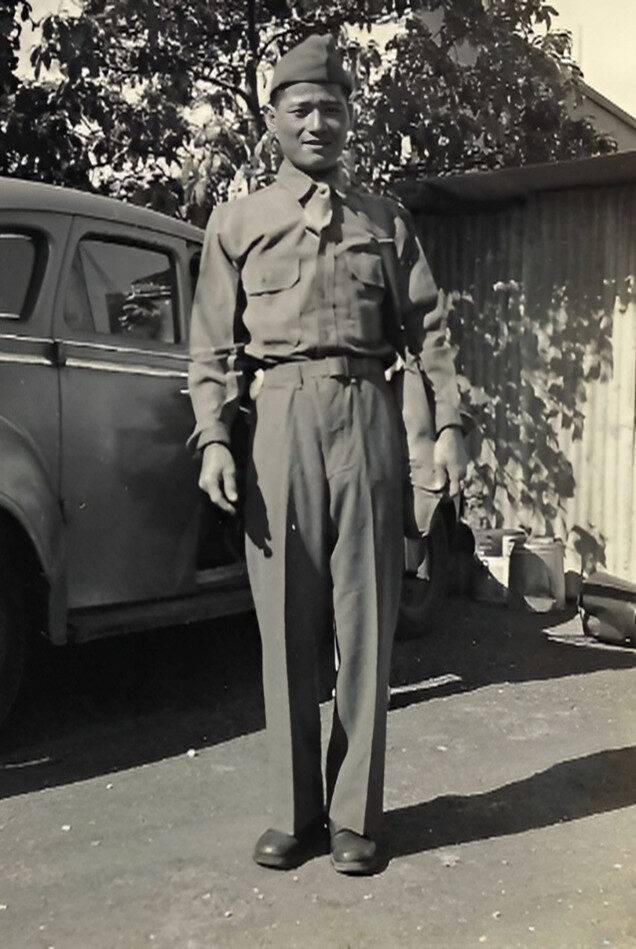Soldier Story: Larry Tamotsu Miyashiro
Soldier Story

Larry Tamotsu Miyashiro
Private
442nd Regimental Combat Team
522nd Field Artillery Battalion, A Battery
Larry Tamotsu Miyashiro was born on March 7, 1924, in Hanapepe, Kauai, Territory of Hawaii. He was the third child of Kamejiro and Matsuya (Kaneshiro) Miyashiro, who arrived from the villages of Taira and Nagoshi, Okinawa Prefecture, Japan, in 1911 and 1912, respectively. His siblings were: brothers Minoru (died in infancy), Susumu, Naoshi, and Sukeo Billy; and sisters Helen Yukiko, Betty Myra Sumiko, Asayo, and Emiko Amy.
In 1930, the family was living in Koloa District and father Kamejiro was a fisherman at the fish market. Mother Matsuya died in 1933 when Tamotsu was 9 and there were still five children younger than he. While he was in 5th grade, he participated in the school’s vegetable growing contest. He graduated from Eleele School in May 1939 and received a diploma for two years of work in Future Farmers of America. That summer, Tamotsu was a member of the Hanapepe Sumo Club and was crowned champion in the Class B competition.
In 1940, they were living on Valley Road in Hanapepe. Kamejiro and Tamotsu were working on the sugar plantation and Yukiko was a tailor in a tailor shop. Tamotsu, called Larry, dropped out of Waimea High School after completing his freshman year and began working on the sugar plantation to help support his family.
Below : Larry and his friend Tokiharu Matsukawa about 1938 on a beach in Kauai

Below: Tokiharu (left) and Larry (right) Tokiharu, 1943

Below: Larry Miyashiro

Larry enlisted in the Army in 1943 and left for Oahu with the other new soldiers from Kauai. After arrival in Honolulu they were sent to the “tent city” known as Boom Town at Schofield Barracks. On March 28, they were given an aloha farewell ceremony at Iolani Palace. They sailed on the S.S. Lurline on April 4 to Oakland, California. After their arrival, they went by train to Camp Shelby, Mississippi. Once there, Miyashiro was assigned to the 522nd Field Artillery Battalion, A Battery.
There were about 650 men assigned to the 522nd’s three batteries: A, B, and C were the firing units, each with four 105mm howitzers pulled by a short-wheelbase 6×6 truck. Service and Headquarters Batteries were the support – everything from administration, to mess hall cooks, mechanics, fire control, motor pool, communications, and a Medical Detachment.
Larry’s A Battery consisted of: an Administration and Supply unit; Instrument Section; four Gun Sections; Wire Section; Radio Section; Ammunition Section; Mess Section; and Motor Pool. There were 125 men in A Battery and we do not know what Miyashiro’s role was.
After a year of basic, combat, and specialty training and maneuvers, Private Miyashiro left with the rest of the 442nd on April 22, 1944, for Camp Patrick Henry, Virginia. The Combat Team sailed to the Theater of War on May 2 from nearby Hampton Roads – the 522nd was on the troop ship Johns Hopkins. Most of the ships arrived at Naples on the west coast of Italy on May 28. However, the 522nd arrived at Brindisi and Bari on the east coast of Italy the same day. The 522nd soldiers then travelled by rail boxcars to meet up with the rest of the 442nd at Naples.
The Battalion was at Staging Area No. 4 in Bagnoli, a bivouac near Naples, until June 6, when the Combat Team sailed on LSTs (the 522nd was on LST 526 ) for the overnight trip to Anzio. Upon arrival, they climbed over the side and down the rope nets to the heaving swells below. From Anzio, on June 9 they were sent in a midnight truck convoy around the newly liberated city of Rome to a large bivouac near Civitavecchia.
They entered combat near Suvereto in the Rome-Arno Campaign on June 26. The 105mm howitzers had a range of seven miles, which meant that the gun crews were about 1,000 yards behind the front lines where the infantry was. This required the guns to be moved whenever the Germans retreated and were out of range. The 522nd soon established its reputation as the quickest and most efficient 105mm artillery unit in the European Theater.
After driving the enemy north to the Arno River, on September 6 the 442nd was pulled from the lines and sent south to the port of Piombino, 14 miles from Suvereto. From Piombino they sailed to Naples on September 11. The 522nd sailed aboard the U.S.S. Richard K. Call, while the vehicles of the 522nd were driven to Naples by motor convoy. On September 27, the 522nd sailed on the U.S.S. Thurston from Naples to France. Upon arrival near Marseilles, they were transferred to LSIs (similar to LSTs) and landed on the beach in high seas, rain, wind, and mud. The next day, they were sent by rail boxcars and motor convoy to Battalion Area No. 51, a bivouac near Septèmes. During the 10-day stay in their bivouac, day passes to Marseilles were issued and the 442nd men also helped unload cargo at the port.
The 522nd fought in support of the 442nd during the Rhineland-Vosges Campaign. They left Septèmes by motor convoy on October 9 for the nearly 500-mile trip north to the Vosges Mountains. After two overnight halts, they arrived at the Seventh Army assembly area near Pouxeux on October 11. After going to two more assembly areas closer to the front, the attack began in the vicinity of Bruyères on October 14.
Pvt. Miyashiro was in combat during the bitter fighting to liberate the important rail and road junction of Bruyères, neighboring Biffontaine and Belmont, and the “Rescue of the Lost Battalion” – the 1st Battalion, 141st (Texas) Infantry that had advanced beyond the lines and was surrounded on three sides by the enemy. Prior to the actual rescue of the 141st, the 522nd had “saved” them by correctly questioning the 36th Division commander on his firing orders. The 522nd forward observers noted that the firing coordinates ordered by the Commanding General were in the middle of the Lost Battalion’s position – so the coordinates were changed.
The weather was cold, wet, snowy, and miserable as the men fought in the heavily wooded forests still in their summer uniforms. They were subjected to living in water-logged foxholes, and incoming artillery raining down on them in “tree bursts.” Many 442nd soldiers contracted trench foot during these terrible weather conditions.
After the fierce fighting in the Vosges, the 442nd was at half-strength due to high casualties, and was sent to the south of France. There, they could rebuild to full combat strength while fighting in the Rhineland-Maritime Alps Campaign. This was primarily a mission of maintaining a defensive position to guard against enemy incursion from Italy to the east.
The 522nd left the lines on November 17 and moved to an assembly area near Cheniménil, eight miles southwest of Bruyères, and arrived near Nice on the Mediterranean coast on November 21. The 442nd was in the area of Nice, Menton, Sospel, L’Escarène, and Peira Cava, and they received replacements during this time. However, the 522nd did not need replacements as they remained at combat strength during the Vosges Campaign. The period was relatively calm and was nicknamed the “Champagne Campaign” as the men were often given passes to Nice on the French Riviera. While there, the 522nd was mostly stationed in Sospel and, later, Menton. The drive to Sospel was 45 miles from the coast up steep, winding, narrow mountain roads.
The time in France ended when the 442nd RCT was sent back to Italy on March 22-25, 1945, for combat in the Po Valley Campaign. Commanders of the Fifth Army and the Seventh Army argued among themselves for the privilege of having the 522nd assigned to their command in Italy or Germany. As it turned out, the 522nd Battalion was detached and sent to Germany for combat with the Seventh Army in the Central Europe Campaign, adding firepower to its assault on the Siegfried Line.
The 522nd left Menton on March 9 and convoyed 500 miles north, arriving on March 12. They crossed the Saar River into Germany at Kleinbittersdorf. For the next two weeks, the Battalion supported a breakthrough of the Siegfried Line, captured a German 150mm howitzer and used it against the enemy, supported the 45th Infantry Division’s crossing of the Rhine River near Worms, and captured 21 prisoners. The 522nd crossed the Rhine River in the middle of the night on March 27 and 28 on a treadway pontoon bridge.
During its seven weeks of combat in Germany, the 522nd was assigned to general fire support missions reinforcing the firing and assault advances of numerous units of the 7th Army driving the German forces toward the Austrian border, firing 15,219 rounds of artillery fire, making 52 different displacements covering 617 miles enroute. The 522nd moved so rapidly that they were often ahead of the infantry they were supporting.
The 522nd FAB was near Shaftlach in Bavaria, southern Germany, when the Germans surrendered on May 8, 1945.
During the occupation, the 522nd was stationed in and around the town of Donauwörth on the Danube River, 70 miles north of Munich. They performed the usual occupation duties and were often issued passes to visit such places as Hitler’s Eagle’s Nest, Königsee, and Salzburg. By late November 1945, all the men of the 522nd had been sent back to the States.
Pvt. Larry Miyashiro was at Camp Beale, Marysville, California, in December awaiting transportation back home to Hawaii. He decided to reenlist, which he did on December 24, 1945, into the Quartermaster Department. His reenlistment papers stated that he was single with dependents, indicating that he was still helping to support his family. In addition, the papers noted that his Enlistment Term was for the Hawaiian Department.
Where in Hawaii he spent the next 18 months was not found in our research. Some of it was spent in an Army hospital as he was suffering from mental issues, possibly what we now call PTSD from his wartime service. Upon release from the hospital, he was discharged from the Army on October 17, 1947.
For his military service, Private Larry Tamotsu Miyashiro was awarded the Good Conduct Medal, European-African-Middle Eastern Campaign Medal with four bronze stars, World War II Victory Medal, and Army of Occupation Medal. He was posthumously awarded the Congressional Gold Medal on October 5, 2010, along with the other veterans of the 100th/442nd Regimental Combat Team. The award states: “The United States remains forever indebted to the bravery, valor, and dedication to country these men faced while fighting a two-fronted battle of discrimination at home and fascism abroad. Their commitment and sacrifice demonstrate a highly uncommon and commendable sense of patriotism and honor.”
After the war, Sgt. Royce E. Higa of A Battery, wrote about what they had experienced during the war:
We arrived at Camp Shelby, Mississippi, as essentially young adults but quickly molded into men…..Sleeping on hard ground in the company of ticks and chiggers made life miserable. Snow and rain added to the misery. Fear of injury, of being dismembered, and of being killed terrorized us. Calisthenics, close order drills, forced marches, and hikes added to our hardships…The scary fact that soldiers were expendable while military hardware was not, put fear in our hearts. Fear accompanied us everywhere. Stress symptoms included nervousness, tenseness, sleeplessness, and nerve rashes. Controlling irregular movements of our lips, arms, hands, voices, and twitches was not easy on our macho image. These factors caused tremendous stress.
Larry T. Miyashiro died on May 5, 1948, at the age of 24. He was survived by his father and all of his siblings. The urn containing his ashes was held for burial at the National Memorial Cemetery of the Pacific at Punchbowl, which occurred on September 5, 1951, Section Q, Plot 1387. Father Kamejiro applied for his tombstone at Punchbowl and gave his address as 3450-A Maunalei Avenue in Honolulu. Brother Sukeo was buried next to Larry after his death on July 17, 2007.
Brother Sukeo Miyashiro served in the U.S. Army during World War II from 1945 to 1947 in the Corps of Military Police and the 8276th Service Unit, Headquarters & Headquarters Company as an auto mechanic.
Researched and written by the Sons & Daughters of the 442nd Regimental Combat Team in 2025.